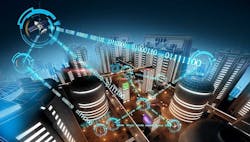SUNNYVALE, Calif. – Smart city initiatives have the potential to alter the urban landscape of major cities, but must overcome a series of significant hurdles to succeed. That was the key takeaway from the Infrastructure Masons’ Think Tank at the group’s recent Leadership Summit.
The session was the first in a series of Think Tank conversations organized by the iMasons, whose mission is to unite the builders of the Digital Age. The discussion brought together more than 100 thought leaders in the data center and cloud industries to brainstorm about the coming digital transformation. Data Center Frontier worked with the Infrastructure Masons to develop the questions for the Think Tanks.
A key theme was that the technology to enable smart cities is close at hand, but political and cultural challenges will take longer to resolve, and provide a high-stakes test for the tech industry’s ability to secure mission-critical infrastructure. Smart cities also rise important questions about privacy and data ownership and management.
For context, here is the question the iMasons sought to address in the April 19 session:
“Smart Cities and our Digital Urban Future – The Smart Cities movement advances a vision of cities using data from urban sensor networks to automate and manage many elements of everyday life. Advances in autonomous vehicles raise additional possibilities, including the deployment of V2V (vehicle-to-vehicle) and V2I (vehicle-to-infrastructure) technologies to manage traffic flow, parking and loading/unloading. What’s the real potential for Smart Cities, and what are the key steps in realizing these visions of a digital urban future?”
The Smart City: Opportunities
Smart city technologies can bring many benefits by using sensors and data to deliver municipal services in a more efficient and personalized manner. The key opportunities identified by the iMasons include:
- The ability to create personalized dashboards for city residents, summarizing key info on weather, traffic, events and municipal services – “painting a picture of what’s happening in the city today.”
- Improved public safety through security monitoring and shift to LED-equipped smart light poles (which can also support WiFi).
- Opportunities for augmented reality (AR) and mixed reality in commerce, entertainment and social acivity.
- Improvement of public health and quality of life via better monitoring of air quality and other environmental factors. Improved city design and access to services could reduce stress and benefit health.
- Crowdsourcing and data sharing can build community and develop new programs and services.
- Creating partnerships for companies and government on data sharing.
A number of the benefits were associated with autonomous cars and the potential for services enabled by V2V and V2I wireless communication. Here’s a few of the ideas the iMasons shared:
- Reducing accidents and improving traffic flow by building intelligence into traffic lights, which eventually will communicate with autonomous cars.
- Repurposing land dedicated to parking, as autonomous cars will be able to come and get passengers on demand. Loading and unloading zones will be new features.
- Autonomous vehicles can supplement mass transit, automating bus and shuttle routes.
- Improved traffic flow could allow public officials to optimize evacuation planning in the natural disasters.
Where To Begin?
A major discussion point centered on how to get started on these transformative projects. Should cities develop from scratch? Should they mesh an IoT network on top of existing infrastructure? Some iMasons advocated for a fresh start, using a public-private development strategy, while others favored utilizing current infrastructure.
An area of agreement was that the implementation of these services is likely to occur in phases. Because of their expense, early smart cities initiatives have been tied to large public events, such as the Olympics (especially Rio de Janiero) or Super Bowl games. These events provide a focal point and timeline for implementation, driven by the city’s effort to capture tourism revenue or burnish its reputation as a travel destination.
Winston Saunders of Microsoft shares during the Think Tank session at the recent Infrastructure Masons Leadership Summit. (Photo: Infrastructure Masons)
One priority is the instrumentation of key urban infrastructure through the placement of sensors, wireless antennas, and cameras, which could be linked together by software to create customizable dashboards to help city officials and residents. Once the platform is created, services can become more efficient. Cost avoidance and cost reduction in existing services are the first priorities, with targeted spending up front to unlock savings through efficiency. This could be followed by a capital investment plan to implement additional infrastructure and services. Several discussions highlighted the importance of public-private partnerships to fund technology investment and provide ways for entrepreneurs to build new services atop the smart cities platform.
The Smart City: Challenges
Although opportunities abound in the smart cities movement, the iMasons Think Tank dug into the many challenges, and how they might be addressed.
The economics of developing smart cities was a hot topic, among the various challenges discussed.
Another major barrier may be political. Creating and implementing a smart cities strategy will require political will and a paradigm shift, participants noted. Meanwhile, America’s recent track record on infrastructure investment is mixed at best. Smart cities will require major investment in technical infrastructure. Local officials will need to sort out how to fund these projects, and the benefits of sharing resources versus owning them.
There was a strong consensus among iMasons that successful smart cities will embrace standardization, which is currently a challenge in the Internet of Things ecosystem. Participants cited the need for defined standards, a common data exchange mechanism, and an open framework and APIs.
Phill Lawson-Shanks of EdgeConneX (center) talks with Aligned Energy CEO Andrew Schaap (left) and CTO and co-founder Jakob Carnemark. (Photo: Infrastructure Masons)
One of the areas of greatest concern with the Internet of Things – and hence smart cities – is security. A smart cities strategy enables new services and greater connectedness, but also has the potential to expose more IT and municipal resources to cyberattacks. iMasons said these systems will require strict authentication and access control.
Privacy issues will also come to the fore in wired cities, several participants predicted, particularly in public/private partnerships where data will be shared to optimize services. Some business models for smart cities envision new services being supported by advertising (already a common feature of most cityscapes).
Cities should also have plans for how to handle the inevitable snafus that happen in large IT projects. iMasons participants said the political backlash could be more significant with smart cities projects, especially with controversies regarding security.
Next: A recap of the iMasons Think Tank on edge computing.
About the Author


